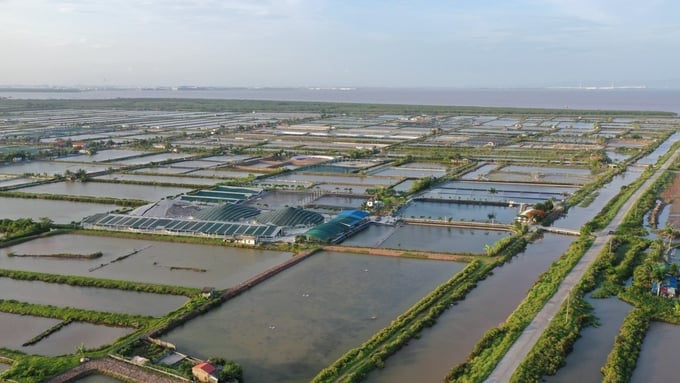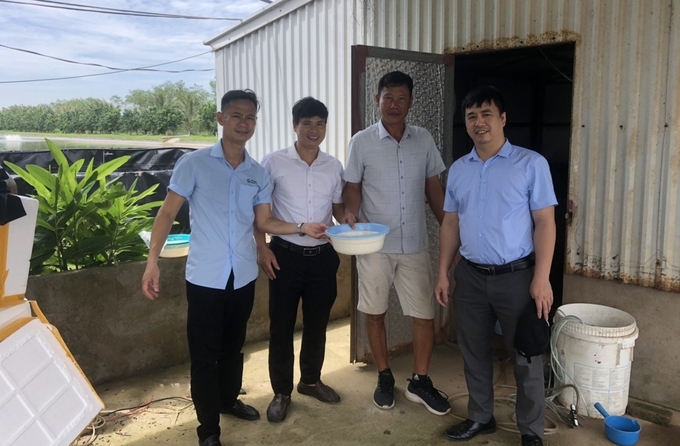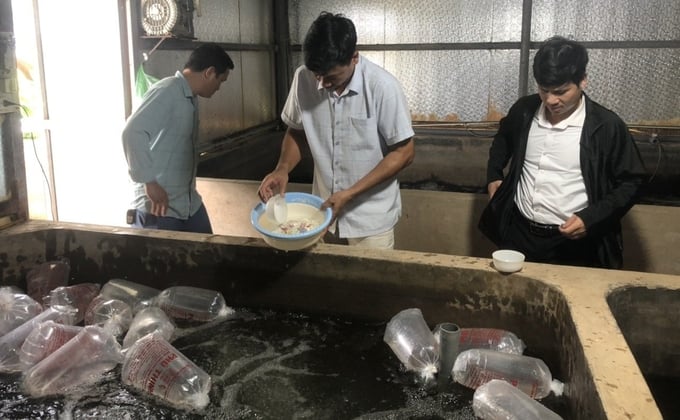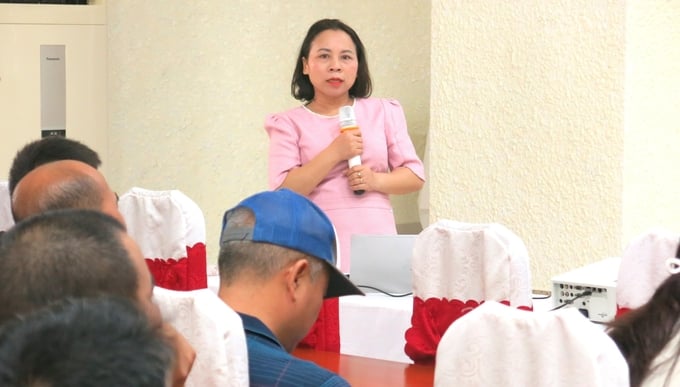May 28, 2025 | 03:38 GMT +7
May 28, 2025 | 03:38 GMT +7
Hotline: 0913.378.918
May 28, 2025 | 03:38 GMT +7
Hotline: 0913.378.918
Hai Phong City has enormous potential and benefits for expanding aquaculture in freshwater, brackish, and saltwater locations, with an estimated area of about 11 thousand hectares, centered in districts such as Tien Lang, Vinh Bao, An Lao, Kien Thuy, Kien An, and so on, with numerous aquatic species.

Hai Phong has great potential for aquaculture, especially shrimp farming. Photo: Dinh Muoi.
Among these, green tiger shrimp is a high-value aquaculture species that has thrived in Hai Phong since 1998. However, due to a lack of technical skill and management, as well as low survival rates (45-50%) and small harvest sizes, productivity has remained low (only 1.5 - 2 tons/ha) and inefficient, forcing farmers to maintain a moderate level of cultivation rather than expanding.
Based on this reality, the Hai Phong City Agricultural Promotion Center recently conducted a survey and carried out the project "Building a model of all-male green tiger shrimp farming in two phases linked to product consumption" at a farming home in Tien Minh commune, Tien Lang district.
This home fits the criteria for model building, such as being located away from residential areas, factories, and hospitals; having an unpolluted water supply system; ensuring aquaculture standards; and being part of Hai Phong City's aquaculture plans, as allowed by local authorities, among others.
Mr. Pham Van Nhieu (the model owner) stated that using traditional methods, the environment frequently fluctuated, shrimp shedding was difficult, diseases were common, particularly in the final stages, shrimp were frequently covered in algae, turned black, became infected with bacteria, and died sporadically. As a result, people frequently had to employ disease prevention methods, and some households had to use antibiotics.

Implementing a 2-phase all-male freshwater prawn farming model at Mr. Pham Van Nhieu's household. Photo: Dinh Muoi.
Following the model's selection and implementation, Mr. Nhieu's family received not only technical assistance, but also training, technology transfer, and product consumption connection. Previous shrimp farming limits have been addressed, and economic efficiency has increased.
During the implementation process, Mr. Nhieu's family received assistance from two specialists sent by the Hai Phong Agricultural Promotion Centre. These are experienced fisheries promotion professionals who can guide farmers through aquaculture development and provide technical guidance for two-phase all-male green tiger shrimp farming in accordance with VietGAP requirements.
The model's technical team and household owners assess shrimp growth rates on a monthly basis in order to implement positive care measures. The Hai Phong Agricultural Promotion Center also conducts regular inspections to track the success of model implementation.
The harvest data suggest that the shrimp have a relatively high growth rate, with a male ratio of more than 95% and commercial shrimp that are consistent in size. The average profit per hectare surpasses 800 million VND, representing a 30-55% increase over traditional approaches.

Two technical staff from the Hai Phong Agricultural Extension Center directly went to the facility to support Mr. Pham Van Nhieu's family in implementing the model. Photo: Dinh Muoi.
Dr. Dang Thi Thanh, Head of the Aquaculture Technical Transfer Department (Hai Phong Agricultural Promotion Center) and project leader, stated that farming all-male green tiger shrimp yields much higher efficiency than regular green tiger shrimp farming because male shrimp grow faster, resulting in larger and more uniform-sized commercial shrimp.
Traditionally, the presence of females in the herd causes energy loss from reproductive activity, resulting in higher growth discrepancies between males and females.
There are numerous benefits to the two-phase shrimp farming model, including: smaller pond areas that are easier to manage; larger-sized seedlings achieved before stocking, shortening the farming period; reducing bottom environment stress; increasing density, productivity, and yield; minimizing diseases, costs, and risks, and so on.
According to the Hai Phong Agricultural Promotion Center, the execution of the methodology has resulted in a comparatively high monthly shrimp growth rate. Because the breeding stock is all-male green tiger shrimp with a male ratio of more than 95%, the commercial shrimp size is quite consistent.

Dr. Dang Thi Thanh shared about the effectiveness of the 2-phase all-male giant freshwater prawn farming model. Photo: Dinh Muoi.
With traditional farming techniques, the environment swings frequently, shrimp shedding is difficult, and diseases are common, particularly in the final stage, when shrimp are frequently covered in algae, turn black, suffer from bacterial infections, and die on occasion. Farmers frequently have to utilize disease preventive strategies, and some must use antibiotics.
Using all-male green tiger shrimp paired with two-phase farming helps overcome herd fragmentation, resulting in faster shrimp growth and higher survival rates.
It also helps to shorten the farming period, increasing economic efficiency per unit area, introducing new directions, and ecologically friendly practices, among other benefits.
Dr. Dang Thi Thanh believes that the successful project of farming all-male green tiger shrimp in two phases linked to product consumption has opened up new aquaculture opportunities for people by lowering the risk of pond environmental pollution, limiting diseases, and ensuring stable shrimp production and productivity.
When adopting the strategy, the Hai Phong Agricultural Promotion Center made product consumption a required requirement for entities providing breeding stock and supplies. The firm not only delivers input materials to increase the market, but it also assists farmers in selling their products at market-appropriate prices. Farmers and businesses profit practically.

Stocking all-male giant freshwater prawns in 2 stages yields 30 - 55% higher than traditional farming methods. Photo: Dinh Muoi.
Furthermore, signing the promise gives farmers confidence in their production, eliminating pressure from dealers to cut prices. At the end of the farming season, households preparing for harvest will contact the purchasing unit to set up a suitable schedule. This relationship promotes advantageous conditions for farmers, and while prices are market-driven, they are not forced down.
Dr. Thanh emphasizes that the model has assisted farmers in shifting their mindsets, actively implementing new technology, and producing safely in accordance with VietGAP requirements for sustainable development. Farmers also reap practical benefits such as lower feed and chemical expenses, reduced disease incidence, pollution control, and higher survival rates.
The model has showed increased effectiveness and great scalability. Furthermore, product consumption connection has fostered confidence in producers, preventing dealers from putting pressure on prices. This improves economic efficiency, income for farmers, and provides new opportunities in aquaculture for the population.
Translated by Linh Linh
/2025/05/25/4127-3-073637_820.jpg)
(VAN) Thanks to the promotion from an FAO-implemented project, vegetable production in greenhouses in Moc Chau has seen strong development, from 1.5 hectares in 2021 to nearly 50 hectares in 2024.

(VAN) FAO has recently supported USD 140,000 to implement the project 'Risk mitigation human-animal interface risks through disease control initiatives in pig farming.'

(VAN) The People's Committee of Tra Vinh province has approved an adjustment to the investment policy for the Green Hydrogen Plant project, increasing its area to approximately 52.76 hectares.
![Reducing emissions from rice fields: [2] Farmers’ commitment to the soil](https://t.ex-cdn.com/nongnghiepmoitruong.vn/608w/files/news/2025/05/05/dsc08881jpg-nongnghiep-140632.jpg)
(VAN) Clean rice cultivation model in Thuong Tan commune, Bac Tan Uyen district, is assisting local residents in achieving sustainable agriculture by substantially reducing costs, increasing productivity, and protecting the environment.

(VAN) At the conference to disseminate Resolution No. 68, AgriS introduced its digital agricultural ecosystem and reaffirmed its commitment to accompanying the Government in promoting private sector development and sustainable agriculture.

(VAN) 'Blue Ocean - Blue Foods' initiative is designed to restore marine ecosystems and establish sustainable livelihoods for local communities by cultivating a minimum of 1,000 hectares of cottonii seaweed in the first three years.
/2025/05/21/4642-3-112707_603.jpg)
(VAN) The V-SCOPE project has made direct contributions to three out of six pillars of the Comprehensive Strategic Partnership between Vietnam and Australia.